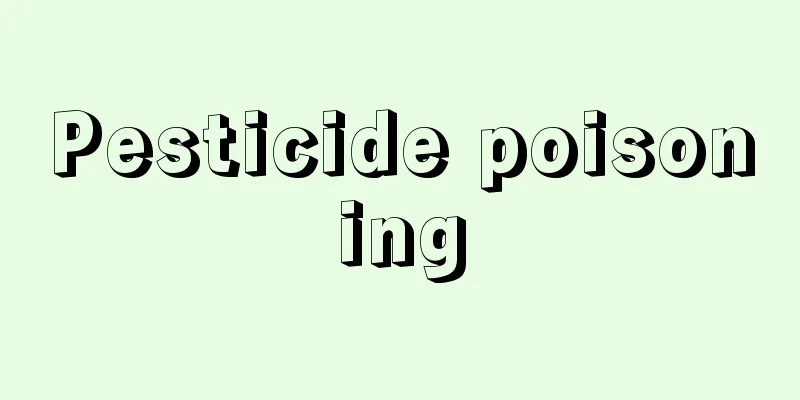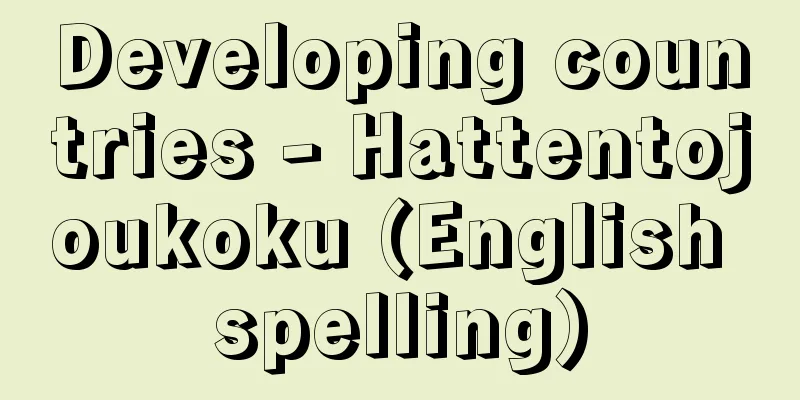Pesticide poisoning

|
Definition/Concept Pesticides include insecticides and herbicides, but many people ingest large amounts of these in suicide attempts, resulting in serious injuries, and they are the second most common cause of death from acute poisoning after gas poisoning. The poison can usually be determined from the victim's notification, but even if they do not, the poison can usually be determined from the circumstances at the scene, such as signs of poisoning, physical findings, and initial symptoms. Treatment consists mainly of symptomatic treatment, including 1) life-sustaining therapy, 2) preventing the absorption of the poison or drug, and 3) removing the absorbed substance, but 4) if antidotes or antagonists are available, they should be administered in sufficient amounts early on. 1) Insecticide: a) Organophosphorus: Widely used as household insecticides, there are many types. As most are poorly soluble in water, they are used as emulsions with non-ionic surfactants or organic solvents. They are highly toxic and are the number one cause of death from pesticide poisoning. The poisoning effect occurs when acetylcholinesterase (AchE) activity is inhibited, leading to the excessive accumulation of acetylcholine (Ach) (Figure 16-2-1) (Tashii, 2007), resulting in a variety of symptoms. Organophosphorus bound to AchE becomes more strongly bound over time, causing aging, and it takes 35 to 49 days for red blood cell AchE to return to normal, and 28 to 42 days for pseudo-AchE. Symptoms include sweating, salivation, nausea, vomiting, miosis, increased bronchial secretions, and bradycardia as a result of muscarinic action (symptoms of parasympathetic stimulation), muscle fiber spasms, generalized convulsions, and respiratory muscle paralysis as a result of nicotinic action (action on striated muscle), and confusion, coma, and respiratory depression as a result of central nervous system effects. If the vomit is milky white and smells of organic solvent, organophosphate poisoning is suspected. Tests show a decrease in AchE activity, which is nearly zero in cases of large doses of poisoning. The diagnosis can be made almost certain based on the fact that poisoning has occurred and the decrease in AchE activity. In the case of coma or respiratory failure, treatment involves quickly securing the airway and instituting artificial respiration. If it has been 2-3 hours since the poisoning, gastric lavage is performed, followed by intestinal lavage. Activated charcoal adsorbs organic substrates, so it is useful before the phosphate substrate is released. Forced diuresis and blood purification methods are unlikely to promote drug removal. As an antagonist, PAM (pralidoxime iodide) (Figure 16-2-1) should be administered early (within 24-36 hours) in sufficient amounts (1000 mg over 30 minutes, then 500 mg every hour by intravenous drip). Atropine sulfate antagonizes the action of acetylcholine on muscarinic receptors (Figure 16-2-1), and in the presence of bradycardia or marked miosis, it should be administered repeatedly (intravenously at least 1 mg) until symptoms improve. b) Carbamates: Carbamates are the second most frequently used insecticides after organophosphates. Like organophosphates, their mechanism of toxic action is to inhibit cholinesterase, causing similar symptoms. However, carbamates are quickly hydrolyzed and cholinesterase is reactivated, so symptoms recover quickly. Treatment is the same as for organophosphate poisoning, but PAM is not required as an antagonist, and atropine sulfate is used as monotherapy. 2) Herbicides: a) Paraquat: Paraquat is a herbicide that contains a bipyridylium ring, which is reduced by NADPH in the body to become the paraquat free radical, which causes dysfunction in various organs (Figure 16-2-2). Symptoms include violent vomiting that inevitably occurs immediately after ingestion due to the addition of an emetic. It causes severe tissue damage, and if ingested orally, it will cause erosions and ulcers in the mucous membranes of the lips, oral cavity, pharynx, esophagus, and stomach. In cases of large-scale poisoning, sudden circulatory failure occurs early on and death occurs. If circulatory failure does not occur, renal and liver dysfunction will occur 2-3 days after ingestion, and interstitial pneumonia and pulmonary fibrosis will occur 1-2 weeks later, resulting in a poor prognosis. If there is no lung damage during this period, in the majority of cases the patient will recover without any aftereffects. There are no characteristic test findings, but in severe cases, hypokalemia and metabolic acidosis are often observed. The diagnosis is confirmed by qualitative analysis of urine (adding sodium hydroxide + sodium hydrosulfite to urine immediately turns blue). There are no specific antidotes or antagonists, so treatment is similar to that for general drug poisoning. Gastric lavage should be performed early and thorough, and intestinal lavage should be performed aggressively. Kayexalate is about 10 times more effective as an adsorbent than activated charcoal. Forced diuresis has no effect in promoting excretion, and fluid infusion is administered to maintain urine output at about 1-2 mL/kg/hour. There is no evidence that DHP, immunosuppressants, or antioxidants improve the prognosis (Kamijo, 2009). Pulse therapy with steroid hormones is used to prevent shock, adrenal insufficiency, pulmonary edema, and interstitial pneumonia in the early stages of poisoning. Oxygen administration should be kept to a minimum as it increases the toxicity of paraquat. The fatality rate is extremely high, reaching over 80%. b) Amino acid herbicides containing phosphorus: Glufosinate and glyphosate are being used increasingly as alternative herbicides to highly toxic paraquat formulations. Glufosinate inhibits glutamine synthetase, suppressing ammonia metabolism, causing ammonia to accumulate in plants and resulting in their death. In mammals, ammonia metabolism is not inhibited due to other metabolic pathways, and the toxicity is considered to be relatively low. However, severe cases and delayed symptoms are not uncommon, and deaths have been reported, and poisoning of more than 100 mL can easily become severe. Shortly after ingestion, symptoms of direct gastrointestinal irritation appear, including nausea, vomiting, abdominal pain, oral mucosal erosion, and gastritis, followed by central nervous system symptoms such as excitement and retrograde amnesia. In some cases, severe symptoms may appear due to gastrointestinal irritation and increased vascular permeability caused by the surfactants contained in glufosinate formulations. Even if there are few initial symptoms, severe delayed neurological symptoms such as delayed loss of consciousness, generalized convulsions, and respiratory arrest may appear 6 to 40 hours later (Koyama, 2006). Diagnosis is difficult without evidence of poisoning. If vomitus (blue-green), clinical symptoms, and sudden delayed neurological symptoms appear, then this type of poisoning should be suspected. There are no specific antidotes or antagonists, and treatment involves gastric lavage, laxatives, and the administration of activated charcoal. As glufosinate is easily excreted by the kidneys, forced diuresis is performed along with intravenous fluid administration. Even if the initial symptoms of this type of poisoning are mild, the need for artificial respiration and the possibility of loss of consciousness or death should be explained, and the patient should be hospitalized for around two days and under strict management. Glyphosate itself has low toxicity, and symptoms experienced when ingested are believed to be due to the surfactants contained in the compound. Gastrointestinal irritation causes vomiting, diarrhea, and gastrointestinal bleeding. Increased vascular permeability also causes a drop in blood pressure and generalized edema. The drop in blood pressure gradually becomes more pronounced, leading to hypovolemic shock, and in some cases death may occur even with massive fluid infusions or administration of catecholamines. There are no specific antidotes or antagonists, so activated charcoal is administered after gastric lavage. Urinary excretion of glyphosate is increased by alkalizing the urine with sodium bicarbonate. In cases of large-scale poisoning, hemoperfusion is effective against surfactants. Circulatory management is also important, and if blood pressure drops, circulatory dynamics must be monitored with a Swan-Ganz catheter, and sufficient fluids and dopamine, norepinephrine, etc. must be administered. c) Aniline herbicides: Aniline herbicides are hydrolyzed in the body to produce aniline derivatives, resulting in methemoglobinemia (met-Hb). Not only is the Fe 3 + in met-Hb unable to bind to oxygen, but the oxygen dissociation curve shifts to the left, reducing oxygen transport capacity. Various symptoms of hypoxia appear depending on the level of met-Hb in the blood. When met-Hb concentrations are below 30%, symptoms are mild (fatigue, headache), but when they reach 30-50%, the circulatory and central nervous systems are depressed (weakness, headache, tachypnea, tachycardia, moderate dyspnea). When they reach 50-70%, severe symptoms occur (stupor, bradycardia, respiratory depression, convulsions, acidosis), and when they reach 70% or higher, it is fatal. Test results show methemoglobinemia, hemoglobinuria, elevated serum indirect bilirubin, AST, and ALT, and a dissociation between arterial blood oxygen saturation (decrease) and P a O 2. If arterial blood, lips, or mucous membranes are chocolate-colored, methemoglobinemia is suspected and a definitive diagnosis is made using gas chromatography. As a treatment, methylene blue is administered if the met-Hb concentration is 30% or higher. In cases in which methylene blue administration is ineffective, exchange transfusion is effective. [Tase Choichiro] ■References <br /> Kamijo Yoshito: Paraquat. Clinical Toxicology (edited by Souma Kazuhito, written by Kamijo Yoshito), pp260-267, Igaku-Shoin, Tokyo, 2009. Koyama Kanji: Glufosinate. All about Poisoning (edited by Kurokawa Akira), pp215-218, Nagai Shoten, Osaka, 2006. Tase Choichiro: Representative toxic substances: organophosphate insecticides and carbamate insecticides. Emergency and intensive care, 19: 437-442, 2007. Mechanisms of onset and treatment of organophosphate poisoning "> Figure 16-2-1 Mechanism of cytotoxicity of paraquat "> Figure 16-2-2 Source : Internal Medicine, 10th Edition About Internal Medicine, 10th Edition Information |
|
定義・概念 農薬には殺虫剤,除草剤などがあるが,自殺企図により大量服毒し重症となるものが多く,急性中毒の死因としてガス中毒についで多い.中毒物質は通常は本人の告知により推定できるが,告知がない場合も服毒した形跡など現場の状況,身体所見,初発症状などから大部分は毒物が推定できる.治療は,対症療法としての①生命維持療法,②薬毒物の吸収阻止,③吸収物の除去が主となるが,④解毒薬・拮抗薬などがある場合は早期に十分量投与する. 1)殺虫剤(insecticide): a)有機リン(organophosphorus):家庭用殺虫剤として広く用いられ,その種類も多い.多くは水に難溶であるために非イオン性界面活性剤や有機溶剤により乳剤として使用される.毒性が強く農薬中毒の死因の第1位を占めている.中毒作用はアセチルコリンエステラーゼ(AchE)活性の阻害によりアセチルコリン(Ach)が過剰蓄積(図16-2-1)し(田勢,2007),多彩な症状を呈する.AchEに結合した有機リンは,時間とともに結合がより強固になりエージング(aging)が起こり,正常化には赤血球AchEで35~49日,偽性AchEで28~42日かかる. 症状はムスカリン様作用(副交感神経刺激症状)として発汗,流涎,悪心,嘔吐,縮瞳,気管支分泌物増加,徐脈,ニコチン様作用(横紋筋に対する作用)として筋線維性攣縮,全身痙攣,呼吸筋麻痺,中枢神経作用として意識混濁,昏睡,呼吸抑制などを呈する.吐物が乳白色で有機溶剤臭があれば,有機リン中毒を疑う.検査ではAchE活性値は低下し,大量服毒例ではほぼ0になる.診断は服毒の事実とAchE活性値の低下があればほぼ確定してよい. 治療は昏睡,呼吸不全の場合,速やかに気道を確保し人工呼吸を行う.服毒後2~3時間以内であれば胃洗浄,その後腸洗浄を行う.活性炭は有機基質を吸着するのでリン基質が離れる前の状態では有用である.強制利尿,血液浄化法による薬物の除去促進はほとんど期待できない.拮抗薬としてPAM(pralidoxime iodide,ヨウ化プラリドキシム)(図16-2-1)を早期(24~36時間以内)に十分量(1000 mgを30分で,以後毎時500 mgで点滴静注)投与する.硫酸アトロピンはムスカリン様受容体におけるアセチルコリンの作用に拮抗し(図16-2-1),徐脈や著明な縮瞳がある場合は症状が改善するまで(1 mg以上静注)反復投与する. b)カーバメート(carbamate):カーバメートは殺虫剤としては有機リンについで頻用されている.毒作用機序は有機リン剤同様コリンエステラーゼを阻害し類似の症状を呈する.しかし,カーバメート剤は速やかに加水分解されてコリンエステラーゼは再賦活化されるため,症状の回復は速やかである.治療は有機リン中毒と同様であるが,拮抗薬としてはPAMは必要ではなく,硫酸アトロピン単独療法となる. 2)除草剤(herbicides): a)パラコート(paraquat):パラコートはビピリジリウム環を有する除草剤で,体内ではNADPHにより還元されパラコートフリーラジカルとなり,種々の臓器の機能障害を引き起こす(図16-2-2). 症状は催吐剤の添加による服毒直後の激しい嘔吐が必発する.組織傷害が強く,経口摂取では口唇,口腔,咽頭,食道,胃の粘膜にびらん・潰瘍を形成する.大量服毒例では早期に突然循環不全を生じ死亡する.循環不全がこなければ服毒2~3日後に腎機能や肝機能障害,1~2週間後に間質性肺炎,肺線維症となり予後不良となる.この時期に肺障害がなければ,大多数の症例では後遺症を残さず治癒する. 特徴的な検査所見はないが,重症例では低カリウム血症,代謝性アシドーシスを認めることが多い.診断は尿の定性分析(尿に水酸化ナトリウム+ハイドロサルファイトナトリウムを加えると直ちに青色となる)で確定する. 特異的に作用する解毒薬・拮抗薬はなく,一般の薬物中毒の治療に準じる.早期に十分胃洗浄を行い,積極的に腸洗浄を施行する.吸着剤は活性炭よりもケイキサレートが約10倍すぐれている.強制利尿による排泄促進効果は認められず,尿量を1~2 mL/kg/時程度を保つように輸液を行う.血液吸着(DHP)をはじめ,免疫抑制薬や抗酸化薬なども予後を改善するというエビデンスはない(上條,2009).ステロイドホルモンによるパルス療法は,服毒早期のショック,副腎機能不全,肺水腫や間質性肺炎の予防に用いられる.酸素投与はパラコートの毒性を増強させるため最低限の投与にとどめる.致命率は非常に高く,80%以上にも及ぶ. b)含リンアミノ酸系除草剤(amino acid herbicides containing phosphorus):毒性の強いパラコート製剤に代わる除草剤としてグルホシネート(glufosinate)やグリホサート(glyphosate)の使用頻度が増加している.グルホシネートはグルタミン合成酵素を阻害してアンモニア代謝をおさえ,植物内にアンモニアを蓄積させ枯死させる.哺乳類では他の代謝経路によりアンモニア代謝は阻害されず毒性は比較的低いとされる.しかし,重症例や遅発性障害もまれではなく死亡例も報告され,100 mL以上服毒では重症になりやすい. 服毒早期に消化管直接刺激症状による悪心,嘔吐,腹痛,口腔粘膜びらん,胃炎が出現し,その後,興奮,逆行性健忘などの中枢神経症状が現れる.グルホシネート製剤に含まれる界面活性剤による消化管刺激や血管透過性亢進による重篤な症状を呈する場合もある.初期に症状が乏しくとも6~40時間後に,遅発性の意識障害,全身痙攣,呼吸停止などの重篤な遅発性神経症状を呈することがある(小山,2006). 診断は服毒の事実がなければ困難である.吐物(青緑色)や臨床症状,その後突然の遅発性神経症状が生じたら,本中毒を疑う. 治療として特異的な解毒薬・拮抗薬はなく,胃洗浄,下剤,活性炭の投与を行う.グルホシネートは腎からの排泄が良好なため輸液とともに強制利尿を行う.本中毒では初期症状が軽度であっても,人工呼吸の必要性,意識障害や死に至る可能性を説明し,2日間程度は入院させ厳重に管理する. グリホサートはそれ自体の毒性は弱く,服用した場合の症状は配合されている界面活性剤によるものとされる.消化管刺激症状による嘔吐,下痢,消化管出血が起こる.また,血管透過性亢進により血圧低下や全身の浮腫がみられる.血圧低下は次第に著明になり,循環血液量減少性ショックとなり大量輸液やカテコールアミン投与も追いつかず死亡する場合もある. 特異的な解毒薬・拮抗薬はなく,胃洗浄後活性炭を投与する.炭酸水素ナトリウムによる尿のアルカリ化でグリホサートの尿中排泄が増加する.大量服毒例では界面活性剤に対し血液吸着が有効である.また,循環管理は重要で,血圧低下時にはSwan-Ganzカテーテルによって循環動態をモニターし,十分な輸液とドパミン,ノルアドレナリンなどの投与が必要になる. c)アニリン系除草剤(aniline herbicides):アニリン系除草剤は生体内で加水分解されてアニリン誘導体を生じメトヘモグロビン(met-Hb)血症を呈する.met-HbのFe3+は酸素と結合できないばかりでなく,酸素解離曲線を左方移動させ酸素運搬能は低下する.血中のmet-Hb濃度の程度により種々の低酸素症の症状を呈する.met-Hb濃度が30%以下では症状は軽度(倦怠感,頭痛)であるが,30~50%になると循環器系および中枢神経系の抑制(脱力感,頭痛,頻呼吸,頻脈,中等度の呼吸困難)をきたす.50~70%では重篤な症状(昏迷,徐脈,呼吸抑制,痙攣,アシドーシス)となり,70%以上では致死的となる. 検査成績では,メトヘモグロビン血症,ヘモグロビン尿,血清間接ビリルビン,AST,ALTの上昇,動脈血酸素飽和度(低下)とPaO2の解離がみられる.動脈血や唇・粘膜がチョコレート色を呈していたならばメトヘモグロビン血症を疑い,ガスクロマトグラフィにより確定診断を行う.治療としてはmet-Hb濃度が30%以上の場合はメチレンブルーを投与する.メチレンブルー投与が無効な例では交換輸血が有効である.[田勢長一郎] ■文献 上條吉人:パラコート.臨床中毒学(相馬一亥監修,上條吉人著),pp260-267,医学書院,東京,2009.小山完二:グルホシネート.中毒症のすべて(黒川 顕編),pp215-218,永井書店,大阪,2006.田勢長一郎:代表的な中毒物質 有機リン系殺虫剤,カーバメイト系殺虫剤.救急・集中治療,19: 437-442, 2007. 有機リン中毒の発症と治療の機序"> 図16-2-1 パラコートの細胞毒性機序"> 図16-2-2 出典 内科学 第10版内科学 第10版について 情報 |
Recommend
Tsuchizaki
A port town in Akita County, Dewa Province, locate...
Musaylima (English spelling)
[raw]? [Death] 633 He was one of the so-called &qu...
Tinea cruris (Jock itch)
What is the disease? Occurs in the groin area Tin...
Yoshiyuki Tsuruta
Born: October 1, 1903 in Ishiki, Kagoshima [Died] ...
Pericrocotus divaricatus (English spelling)
...Research on this species has not progressed mu...
Al-`Aqabah (English spelling)
A port city at the southern tip of Jordan. Located...
Sludge
A group of fine particles suspended or deposited ...
Treaty of Alcaçovas
...In 1558, at the request of the Pope, the king ...
Cain complex
A psychoanalytic term that describes conflict betw...
Bibio albipennis (English spelling)
...A general term for insects belonging to the fa...
Lieutenant Asakura
〘Noun〙 A type of Noh mask. It represents an ordina...
Multiplex broadcasting - Tajuuhousou (English spelling)
This refers to broadcasting in which a new signal...
Genre painting (English: genre painting)
Paintings based on real, everyday life. The term ...
Subfamily: Red-tailed Rhinoceros
…The red-backed robin Furnarius rufus breeds in a...
Ventris - Michael Ventris
British architect and decipherer of Linear B, a t...





![Itamuro [Hot Spring] - Itamuro](/upload/images/67caebd96c53f.webp)



